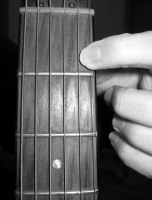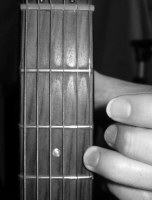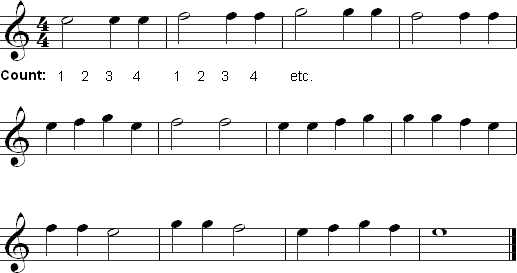What You Should Know
What You Will Learn
- What an open string is
- Where to find E, F, and G on the first string
- Where E, F, and G are located on the treble clef staff
- Basic reading exercises in quarter, half and whole notes for E, F, and G
How to Read Notes on the High E String
The first string is the thinnest string on the guitar. It is also referred to as the high E string.
E, F, and G on the First String
E on the First String
E is the pitch of the open first string. A string is open when no notes are fretted on that string. This E is found on the fourth space on the treble clef staff:

F on the First String
F is on the first fret of the first string. It should be played with the first finger.

Fretting F
F is found on the fifth line of the staff in treble clef:

G on the First String
G appears on the third fret of the first string and should be played with the third finger.

Fretting G
This note appears on the space above the staff.

Note that the fingering suggestions given for each of these notes are only recommendations. These fingerings work well with all of the reading exercises given here, but you shouldn't take this advice to mean that these notes are always played with a certain finger. You may need to use a different finger in certain situations.
Exercises
How to Practice the Exercises
- 1. Play all of these exercises using downstrokes with the pick.
- 2. Count out loud while playing.
- 3. Pay close attention to the fingering. Use the fingerings given for each note above for all the exercises.
- 4. If you find counting and playing too difficult at first, try clapping the rhythms while counting. Once this is comfortable, play the exercise as written.
- 5. Try to read straight through the exercise without stopping to figure out a note.
- 6. Practice very slowly with a metronome.
Exercise 1: E, F, and G in Whole Notes

Exercise 2: E, F, and G in Half Notes

Exercise 3: E, F, and G in Quarter Notes

Exercise 4: E, F, and G in 3/4

Exercise 5: E, F, and G in 2/4

Exercise 6: E, F, and G in Mixed Rhythms

